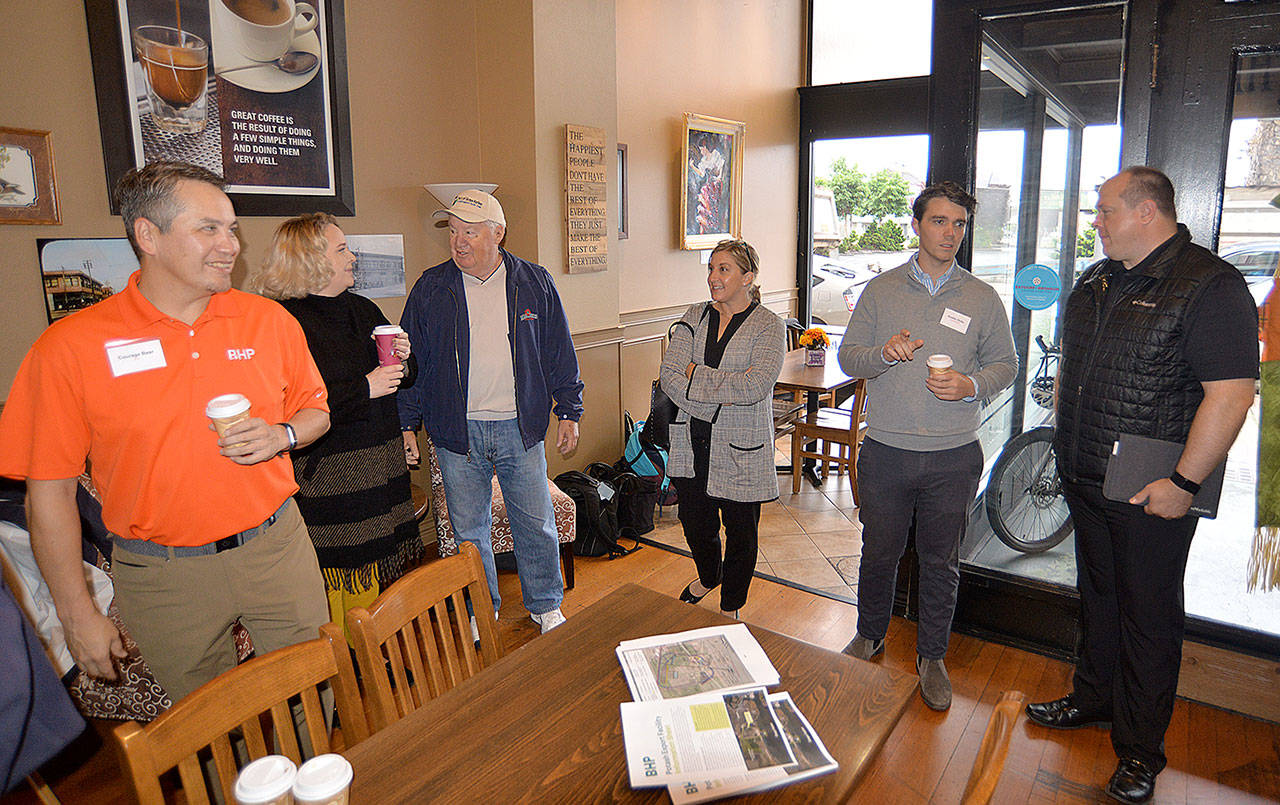Story updated Sept. 23
At the Jitter House in Hoquiam on Wednesday morning, more than 40 people attended a meet-and-greet with representatives from BHP, the global mining company behind a proposed potash export facility on Port of Grays Harbor property near Bowerman Field in Hoquiam.
The event took place two years and a day from one of the company’s first public forums about the project at Hoquiam High School, pointed out Ken Smith, Manager of Corporate Affairs for Potash.
Courage Bear, BHP’s community engagement specialist, said the current round of public outreach regarding the project will continue through next week, with a meeting with the Quinault Indian Nation today and a community outreach there, a presentation at Greater Grays Harbor Inc.’s monthly business forum luncheon Tuesday, and a presentation with the Aberdeen Rotary Club Wednesday.
Along with the formal outreach, Smith said he often finds the informal meetings to be as productive, if not more productive, than just meeting people at random in the region.
He said a lot of questions center around the company itself, what the company’s objectives are, why Terminal 3 at the Port is one of two potential sites under consideration, exactly what potash is, and the lengthy permitting process. Other frequent questions ask for specifics on increases in rail and vessel traffic that would come with the operation, should Terminal 3 ultimately make the cut.
“We’ve been very well received in the area,” said Smith. “People are encouraged by the potential investment, and the 40-50 full-time positions (the facility is estimated to provide).”
The investment is a substantial one for the company. The potash would come from the Jansen Mine in Saskatchewan, Canada, about 90 miles east of Saskatoon. The company spent some $3.9 billion on pre-construction activities such as the shaft sinking and some surface works to prepare for potential construction. The mine includes two shafts, one service shaft and one production shaft, each 21 feet in diameter and 3,200-3,300 feet deep, said Smith.
The potash layer some 3,200 feet below the surface “is like a seabed,” said Smith, about 14 feet thick. For every ton of mined material, about one-third of it will be salable potash, the rest sodium chloride — an unmarketable byproduct that will be treated in accordance with local environmental regulations.
The work on the final liner in both shafts will continue into 2021. The second phase would begin once the BHP board approves the mining operation and a location for the export facility is chosen — the other potential site is in Vancouver, B.C.
Once approved, another $5.3 billion to $5.7 billion would be invested by BHP to provide the infrastructure to export the potassium-based potash, which is water soluble and used primarily to produce fertilizer. That up to $5.7 billion would include the cost of building the export facility.
If Terminal 3 is selected, the facility would receive four to five trains a week, which would ramp up to eight to 10 in coming years. Each train would be about 8,500 feet long. The site would contain three rail loops, said Smith, which would allow an entire train to fit within the facility.
Since potash is water soluble, it must be kept out of the elements throughout the mining, shipping and storage process. The product would be loaded onto sealed rail cars, which are rolled into the facility and into enclosed buildings to unload. The conveyors that carry the product to a storage facility or directly to ships for export would also be enclosed, said Smith.
Smith said the company is basing the potential first shipment of potash to coincide, as best can be forecast, for a period where global demand requires additional supplies.
“Timing is key on the project,” said Smith. With an average supply of 65 million tons a year, with general agreement the market for potash is growing, Smith said the company will wait until demand creeps past supply to start operations. Overall, Smith said the company’s “peers” — those who have been exporting potash over the years — “have seen growth of 1-3% a year.”
The potential Jansen mine and export facility has an estimated lifespan of more than 50 years, Smith said.
Public comment
Documents are available for review online — go to cityofhoquiam.com and hit the “Public Notices” button — or at Hoquiam City Hall at 609 8th St. The documents include a 64-page executive summary posted in July that highlights the information contained in the hundreds of pages included in BHP’s permit application with the City of Hoquiam.
Written comments on the application will be accepted through Oct. 14 attention Brian Shay, City of Hoquiam, 609 8th Street, Hoquiam, WA 98550, or bshay@cityofhoquiam.com.



